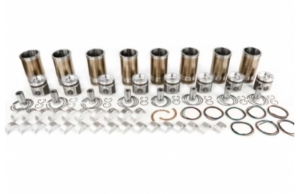June 18, 2025
What Is a Core Charge?
Think of it Like a Bottle Deposit
Why Core Charges Exist
How Core Charges Help Lower the Price of Your Blower
The Core Charge Is Temporary
The Role of Core Charges in Keeping Blowers Available
Your Core Helps Others, Too
What Makes a Blower Core Rebuildable?
What Doesn't Matter:
Telltale Signs That Your Blower Core May Be Unacceptable
How to Return Your Core the Right Way
What Happens After You Send Your Core?
Inside the Rebuilding Process: How Blower Cores Are Remanufactured
Common Customer Questions About Core Charges
Misconceptions About Core Charges
Final Thoughts: Why Core Returns Benefit Everyone
Read More
June 12, 2025
Introduction to the Caterpillar 3400 Series
Key Features of the 3400 Series Engine Family
Differences Between Original, B, C, and E Models
Base Models
B Models
C Models
E Models
Common Aftermarket Components
Engine Overhaul Kits
Cylinder Heads
Turbochargers
Fuel System Components
Cooling System Components
Gasket and Seal Sets
Oil Pumps and Lubrication Parts
Electrical and Sensor Systems
Unique Marine and Industrial Considerations
Marine Environments
Industrial Environments
Serial Nu
mber Reference for Parts Matching
Sourcing Reliable Aftermarket Parts
Warranty
OEM Match Quality
Technical Support and Expertise
Maintenance Best Practices
Fluid Analysis
Break-In Procedures
Scheduled Inspections
Rebuild vs. Replacement Strategy
FAQs About Caterpillar 3400 Series Aftermarket Parts
Conclusion
Read More
June 9, 2025
Final Thoughts on Engine Longevity
How to Maximize Engine Lifespan
Routine Maintenance Without Compromise
Avoid Common Causes of Early Wear
Train the Team
Use Engine Data Effectively
Planning for the Long Term
Closing Perspective
Read More
June 9, 2025
Engine Diagnostics and Error Codes
Handling Complex Issues
When to Call a Professional Mechanic
Best Practices for Long-Term Troubleshooting Readiness
Conclusion
Read More
June 9, 2025
Section 1: Core Hand Tools for Routine Maintenance
1.1 Socket Sets & Wrenches
1.2 Screwdrivers and Nut Drivers
1.3 Pliers and Specialty Grips
1.4 Hex and Torx Key Sets
Section 2: Specialized Tools for Engine-Specific Work
2.1 Valve Lash Adjustment Tools
2.2 Injector Pullers and Installers
2.3 Seal and Bearing Tools
2.4 Crankshaft Turning Tool
Section 3: Diagnostic Equipment and Electronic Tools
3.1 Multimeter (Digital and Analog)
3.2 Diagnostic Scanner or ECM Interface
3.3 Compression and Leak-Down Test Kits
3.4 Fuel Pressure and Flow Gauges
3.5 Infrared Thermometer and Pyrometer
Section 4: Fluid Service and Handling Equipment
4.1 Oil Change Systems
4.2 Coolant Service Tools
4.3 Fuel Handling and Cleaning Tools
Section 5: Workstation and Shop Setup
5.1 Engine Stands and Hoists
5.2 Lighting and Visibility
5.3 Workspace Cleanliness
Section 6: Portable Field Tools and Kits
6.1 Diesel Pro Technician Kit (Example Loadout)
Section 7: Safety Equipment
Conclusion: Build a Toolkit That Matches Your Engine
Read More

June 9, 2025
1. Engine Overheating
Symptoms
Common Causes
Solutions
2. Low Power Output
Symptoms
Common Causes
Solutions
3. Rough Idling
Symptoms
Common Causes
Solutions
4. Exhaust Smoke Issues
Symptoms
Common Causes
Solutions
5. Fuel Delivery Problems
Symptoms
Common Causes
Solutions
6. Battery and Electrical Issues
Symptoms
Common Causes
Solutions
7. Oil Leaks and Related Concerns
Symptoms
Common Causes
Solutions
Final Tips
Read More
Page 2 of 140«12345...102030...»Last »




 Free US Calls: 1-888-433-4735
Free US Calls: 1-888-433-4735 International: 305-545-5588
International: 305-545-5588

